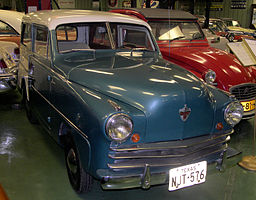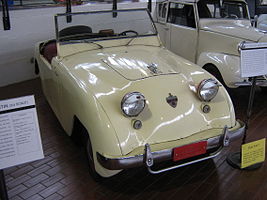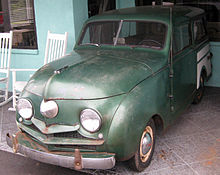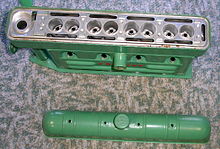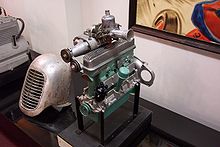- Crosley
-
This article is about a U.S. brand of automobile. For the British vehicle manufacturer, see Crossley Motors. For the U.S. brand of audio technology, see Crosley Radio Corporation.
The Crosley was an automobile manufactured by the Crosley Corporation and later by Crosley Motors Incorporated in the United States from 1939 to 1952.
Contents
History
Industrialist Powel Crosley, Jr., of Cincinnati, Ohio, owner of Crosley Broadcasting Corporation and the Cincinnati Reds baseball team, had ambitious plans to build a subcompact car and with the able assistance of his younger, graduate engineer brother Lewis Crosley, developed assembly plants at Richmond, Indiana, and Marion, Indiana. In May 1939, the first car was shown at the Indianapolis Speedway. It was a two-door convertible that weighed under 1,000-pound (454 kg) and sold for US$250. It did not achieve sales success, but in 1941 more body styles were introduced.
The chassis had an 80-inch (2,032 mm) wheelbase using half-elliptic springs with beam axle in front and quarter-elliptic springs in the rear. The power came from a two-cylinder Waukesha air-cooled engine that had the fan as an integral part of the flywheel. The engine was connected with a three-speed transmission and then directly via a torque tube to the rear axle, thus eliminating the need for joints. However, this arrangement was judged unreliable, and conventional universal joints were fitted beginning in 1941.
In 1941, the body styles available were expanded to include two- and four-passenger convertibles, a convertible sedan, a station wagon, a panel truck, a pickup, and two models called "Parkway Delivery" (a mini-panel with no roof over the front seat) and "Covered Wagon" (a convertible pickup truck with a removable back seat). Crosley's first metal-topped sedan (the Liberty Sedan) was introduced for 1942.
During World War II, the Crosley became attractive because of gasoline rationing and the good mileage it could achieve: 50 miles per US gallon (4.7 L/100 km; 60 mpg-imp). Crosley was the last company to cease production of civilian vehicles in 1942, partly to aid Crosley sales to facilitate fuel conservation, and partly because the War Production Board needed time to determine a use for Crosley's small factories.
Civilian car production resumed at the Marion facility in 1945 with the new, larger and aerodynamic CC model, designed by the firm of Sundberg & Ferar of Royal Oak, Michigan. (The Richmond facility had been sold during the war years.)
Crosley introduced several "firsts" in the American automobile industry, including the first use of the term 'Sport Utility' in 1948 (albeit on an open model based on the wagon, not a wagon on a truck chassis); first mass-market single overhead camshaft (SOHC) engine in 1946; first slab-sided postwar car, also in 1946; first all steel-bodied wagon in 1947; first American car to be fitted with 4-wheel disc brakes in 1949; and the first American sports car, the Hotshot, also in 1949.[1] 1950 brought the Farm-O-Road model, a 63-inch (1,600 mm) wheelbase utility vehicle predictive of the John Deere Gator and other UTVs.
Pre-war production with Waukesha air-cooled I2:
- 1939: Series 1A including convertible Coupe and convertible Sedan
- 1940: Series 2A including Sedan, Deluxe Sedan, Coupe, Covered Wagon, and Station Wagon
- 1941: Series CB41 including Sedan, Deluxe Sedan, Coupe, Covered Wagon, and Station Wagon
- 1942: Series CB42 including Convertible Sedan, Deluxe Sedan, Convertible Coupe, and Station Wagon (all 2-Doors)
Post-war production with CoBra water-cooled I4
- 1946: CC Four including Sedan and Coupe
- 1947: CC Four including Sedan, Coupe, and Wagon 2-Door
- 1948: CC Four including Sedan, Sport Utility Sedan, convertible Coupe, and Wagon
Post-war production with CIBA water-cooled I4
- 1949: CD Four including Deluxe Sedan, Coupe, Station Wagon, Pickup Truck and Panel Truck; VC Four including Hotshot Roadster and Super Sports Roadster
- 1950: CD Four including Sedan, Super Sedan, Coupe, Super Coupe, Station Wagon, Super Station Wagon; VC Four including Hotshot Roadster and Super Sports Roadster; FR Four including Farm-O-Road (in various submodels)
- 1951: CD Four including Business Coupe, Super Sedan, Station Wagon, Super Station Wagon, Super Coupe; VC Four including Hotshot Roadster and Super Sports Roadster; and FR Four including Farm-O-Road.
- 1952: CD Four including Standard Business Coupe, Super Sedan, Station Wagon, Super Station Wagon, Super Coupe; VC Four including Hotshot Roadster and Super Sports Roadster; FR Four including Farm-O-Road. (Crosley, Encyclopedia of American Cars, 2003,)
With 24,871 cars sold, Crosley's best year was 1948. Sales began to slip in 1949, and adding the Crosley Hotshot and a combination farm tractor-Jeep-like vehicle called the Farm-O-Road in 1950, could not stop the decline. In 1952, only 1522 Crosley vehicles were sold. Production ceased after the July 3rd shift that year, and the plant was sold to the General Tire and Rubber Company.
1948 Specs.
Engine HP Transmission Wheelbase Length weight MPG 44 cu in (724 cc) 4-cylinder[2] 26.5[2] 3-speed manual 80 in (2,032 mm) 145 in (3,683 mm) 1,155 lb (524 kg) 35 mpg-US (6.7 L/100 km; 42 mpg-imp)-50 mpg-US (4.7 L/100 km; 60 mpg-imp) [3] Regardless of its short life and small size, the Hotshot is well remembered as a phenomenal sports car within its class. The Hotshot not only won the Index of Performance at Sebring in 1951, but also the Grand de la Suisse that year as well. A Siata 300 fitted with Crosley power won the SCCA's 12 hour Vero Beach race. Throughout, the 1950s Crosley engines dominated 750 cc sports car racing, winning 10 out of 12 SCCA west-coast races alone.[1]
Engines
The original engine is the Waukesha Model 150 Cub Twin, a 580 cc air-cooled L-head opposed twin-cylinder engine built by Waukesha Engines of Waukesha, Wisconsin, and used from 1939 through 1942. It was replaced in 1946 with the CoBra (for "Copper Brazed"), a 724 cc overhead-cam four with a 2.5 in (63.5 mm) bore and 2.25 in (57.2 mm) stroke. That engine in turn was replaced in 1949 by the new and more reliable CIBA (Crosley Cast Iron Block Assembly) engine utilizing five main bearings.
Crosley CoBra (1945–1949)
The CoBra (Copper Brazed, also known as "The Mighty Tin") was originally developed by Lloyd Taylor, of Taylor Engines in California, for military use aboard PT boats and B-17 Flying Fortress bombers. The engine was made from sheet metal rather than cast iron like most other engines. This was done to get a thin, uniform wall thickness and thus avoid the creation of hot spots around the combustion chamber that could ignite the fuel, causing pre-ignition (knocks). These engines were used mainly to power generators, refrigeration compressors, etc., and were widely praised for their successes in the war effort.
The engine was not adopted for automobile use until 1946. It was a very small, very lightweight engine; the block weighed only 14.8 pounds (6.7 kg); complete with all accessories (including the flywheel) weighing only 133 pounds (60 kg). The engine displaced a mere 44 cu in (724 cc) and produced 26 hp (19 kW) at 5,200 rpm. Longevity was not a requirement for their wartime duties, but unfortunately corrosion became a problem for these engines in long-term service, as in automobiles. These problems led to a tarnished reputation by 1948 when used as powerplants in Crosley cars.
CIBA (1949–1952; 1955)
The CIBA (Crosley Cast Iron Block Assembly) was a more traditional and more reliable engine utilizing a cast-iron block. When Crosley Motors, Inc. was sold, the engine was renamed "AeroJet" and production continued. Production of the AeroJet ended in 1955 and the engine rights were sold to Fageol and later to a series of different companies ending in 1972 with the Fisher Pierce Bearcat 55. Maritime modifications mostly included increasing displacement and converting the engine to operate with a vertical axis.
In Europe the Crosley CIBA would be used to great advantage in 750cc sports car class, eventually maturing to a double overhead camshaft (DOHC) design used in the Bandini 750 sport internazionale as well as Nardi and Siata customs.
Notable Crosley owners
- Gordon Baxter (HotShot, story in his book Bax & Car & Driver: The Best of Gordon Baxter)
- General Omar Bradley
- Humphrey Bogart (Two-cylinder Crosley)
- David Carradine (VC Super Sports)
- Kenny Delmar ('Senator Claghorn' on The Fred Allen Show)
- Tommy Dorsey
- President Dwight D. Eisenhower (1951 CD Surrey)
- Geraldine Ferraro (Two-cylinder Crosley)
- Paulette Goddard (Two-cylinder Crosley)
- Pamela Harriman (purchased the first 1939 Crosley)
- George M. Humphrey, Secretary of the Treasury
- Art Linkletter (1952 CD Sport Convertible)
- Alex Raymond, Flash Gordon cartoonist (Crosley-Bandini)
- Nelson Rockefeller, Governor of New York (1950 HotShot)
- Gloria Swanson (Two-cylinder Crosley)
- Fred Waring (Two-cylinder Crosley)
- Frank Lloyd Wright (1952 VC Super Sports)
See also
- Crosley Car Owners Club (CCOC) History
- Powel Crosley Jr.
- Lewis M. Crosley
- Crosley Pup
- WLW
- List of defunct United States automobile manufacturers
References
- ^ "New Crosley Roadster". Popular Science. August 1949.
- ^ a b Kimes, Beverly (1996). standard catalog of American Cars 1805-1942. Krause publications. ISBN 0-87341-428-4.
- ^ "Directory Index: Crosley/1948_Crosley/1948_Crosley_Foldout". Oldcarbrochures.com. http://www.oldcarbrochures.com/static/NA/Crosley/1948_Crosley/1948_Crosley_Foldout/1948%20Crosley-03.html. Retrieved 2011-11-20.
External links
Wikimedia Commons has media related to: - CROSLEY - Two Brothers and an Empire That Changed the Nation - Rusty McClure
- CROSLEY A Compact born 30 years too soon!
- Crosley Car Owners Club (CCOC)
- Crosley Automobile Club Inc.
- West Coast Crosleys
- Crosley Engine Family Tree
- The Mighty Tin (CoBra)
- Crosley at the Open Directory Project
- The Crosley Automobile — A Fine Car
- Crosley Radio Corporation
- Review of the book, Crosley
- Scans from the 1948 Crosley Sales Brochure
- Crosley at the Internet Movie Cars Database
Categories:- Defunct motor vehicle manufacturers of the United States
- Defunct companies based in Cincinnati, Ohio
- Motor vehicle manufacturers based in Indiana
- Compact cars
- Defunct companies based in Indiana
Wikimedia Foundation. 2010.


